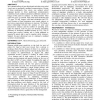Free Online Productivity Tools
i2Speak
i2Symbol
i2OCR
iTex2Img
iWeb2Print
iWeb2Shot
i2Type
iPdf2Split
iPdf2Merge
i2Bopomofo
i2Arabic
i2Style
i2Image
i2PDF
iLatex2Rtf
Sci2ools
GRAPHICSINTERFACE
2000
2000
Effects of Gaze on Multiparty Mediated Communication
We evaluated effects of gaze directional and other non-verbal visual cues on multiparty mediated communication. Groups of three participants (two actors, one subject) solved language puzzles in three audiovisual communication conditions. Each condition presented a different selection of images of the actors to subjects: (1) frontal motion video with 14% gaze; (2) motion video with head orientation and 7% gaze; (3) still images with head orientation and 32% gaze. Presence of head orientation cues caused subjects to use twice as many deictic references to persons. We found a linear relationship between the amount of actor gaze perceived by subjects and the number of speaking turns taken by subjects. Lack of gaze can decrease turn-taking efficiency of multiparty mediated systems by 25%. This is because gaze conveys whether one is being addressed or expected to speak, and is used to regulate social intimacy. Support for gaze directional cues in multiparty mediated systems is recommended. ...
Gaze | GRAPHICSINTERFACE 2000 | GRAPHICSINTERFACE 2007 | Head Orientation | Multiparty Mediated Systems |
| Added | 01 Nov 2010 |
| Updated | 01 Nov 2010 |
| Type | Conference |
| Year | 2000 |
| Where | GRAPHICSINTERFACE |
| Authors | Roel Vertegaal, Gerrit C. van der Veer, Harro Vons |
Comments (0)

